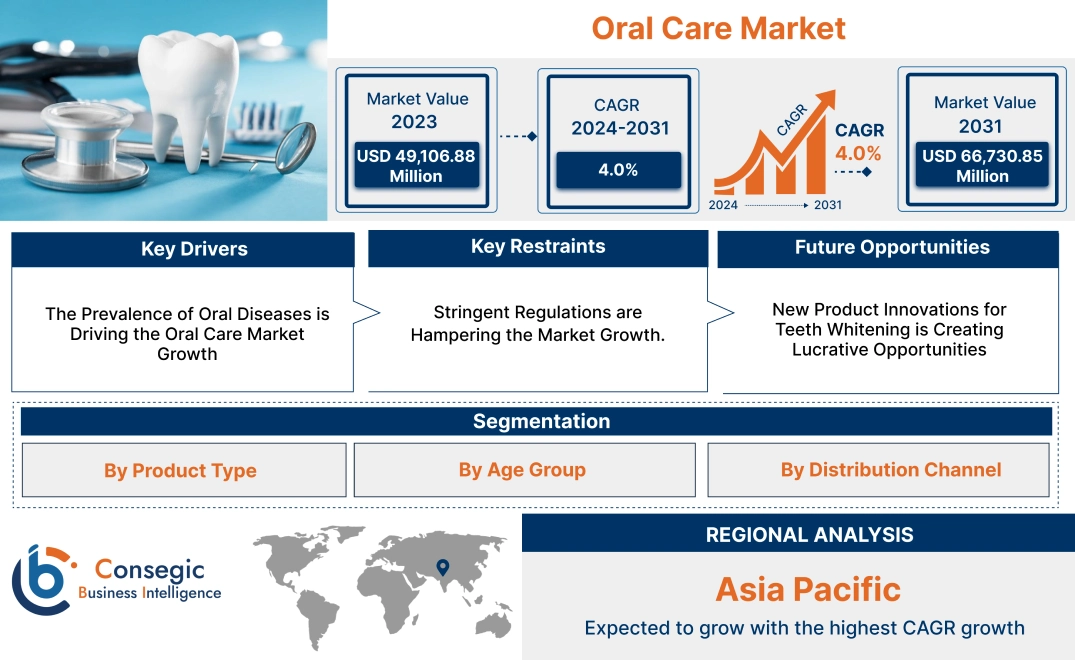- Summary
- Table Of Content
- Methodology
Oral Care Market Size:
Oral Care Market size is growing with a CAGR of 4.0% during the forecast period (2024-2031), and the market is projected to be valued at USD 66,730.85 Million by 2031 from USD 49,106.88 Million in 2023.
Oral Care Market Scope & Overview:
Oral Care refers to the practice of maintaining good hygiene of teeth, gums, and mouth to prevent oral diseases, ensure proper function, and promote overall oral health. It encompasses a variety of activities and products aimed at cleaning the mouth and preventing dental issues such as cavities, gum diseases, and mouth odor. Common oral health care practices include brushing teeth with fluoride toothpaste, flossing to remove food particles and plaque from between the teeth, and using mouthwash to kill bacteria and freshen breathing. Beyond basic cleaning, oral health care includes products designed for specific needs such as whitening toothpaste, sensitive teeth treatment, and orthodontic care among others. These products are available in various online and offline distribution channels.
Oral Care Market Dynamics - (DRO) :
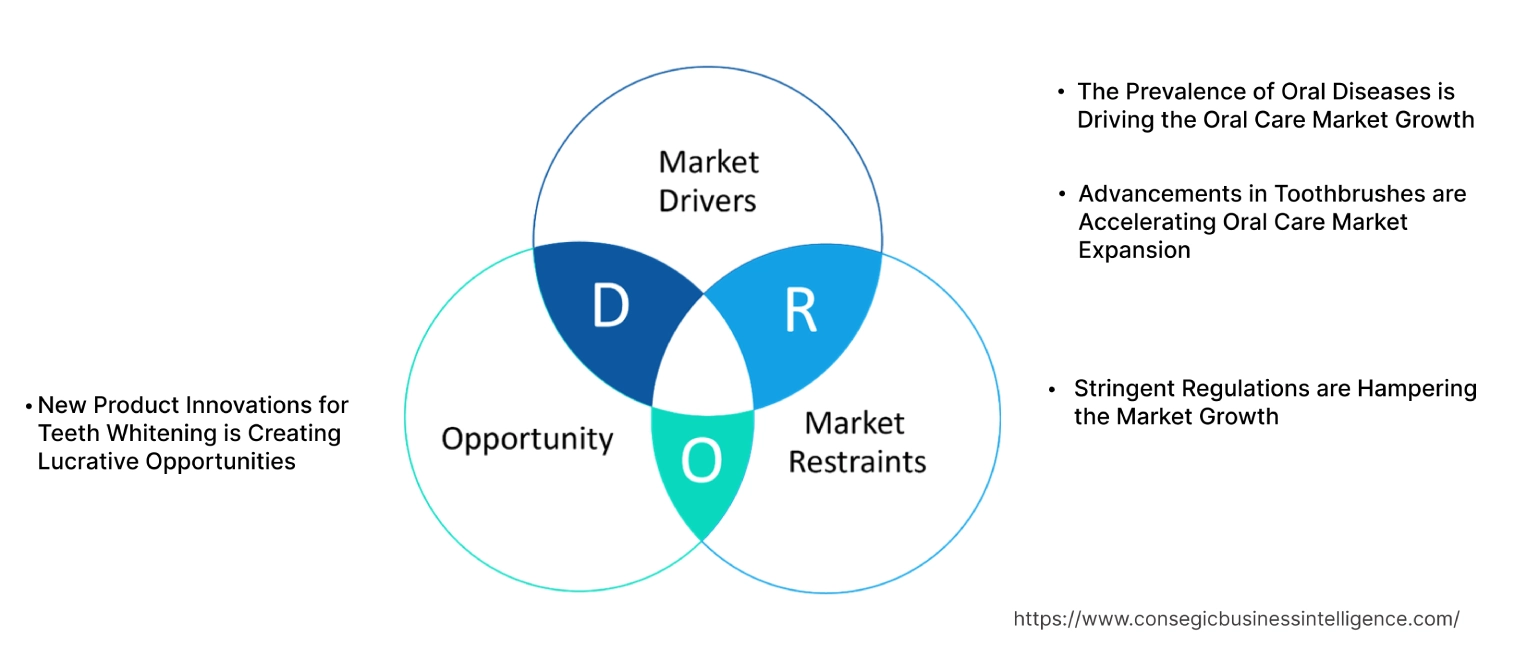
Key Drivers:
The Prevalence of Oral Diseases is Driving the Oral Care Market Growth
The prevalence of oral diseases is a significant driver of the oral care market growth. Dental caries, gum disease, and oral cancer are among the most prevalent oral health problems. Dental caries, gum disease, and oral cancer are among the most prevalent oral health problems worldwide.
Dental caries, commonly known as tooth decay, are caused by bacteria in plaque that produce acids that erode tooth enamel. Gum disease, including gingivitis and periodontitis, is an inflammation of the gums caused by bacterial infection. It led to tooth loss and systemic health issues. These oral health problems significantly impact quality of life, leading to pain, and difficulty eating. The prevalence of these oral conditions influences the use of oral healthcare products.
- For instance, according to the data published in the Global Oral Health Status Report, in 2022, it is estimated that oral diseases affect approximately 3.5 Billion individuals worldwide. This influences the use of oral healthcare products.
Thus, the oral healthcare market is experiencing substantial growth, with consumers investing in products and services.
Advancements in Toothbrushes are Accelerating Oral Care Market Expansion.
Advancements in oral care products such as toothbrushes have influenced dental health, offering innovative solutions for optimal oral hygiene. Electric toothbrushes, for example, offer superior cleaning compared to manual brushes, leading to improved oral hygiene. Additionally, the integration of smart technology into oral health care products, such as smart toothbrushes with pressure sensors and timers, enhances user experience and promotes consistent brushing habits. Manufacturers are introducing novel toothbrushes for better care of teeth, and gums.
- For instance, in 2021, Philips introduced an advanced power toothbrush that consists of SenseIQ technology. This premium electric toothbrush offers advanced features to elevate daily routines.
Thus, the continuous advancements in oral healthcare products, driven by technological innovation, and consumer preferences, are driving the expansion of the market.
Key Restraints :
Stringent Regulations are Hampering the Market Growth.
The oral care market faces significant hurdles due to stringent regulatory landscapes. Stringent regulations governing product formulation, testing, and labeling impose substantial costs and delays on manufacturers. Compliance with these regulations requires extensive documentation, clinical trials, and regulatory approvals, which hinder innovation and product launches.
Additionally, the diverse and often conflicting regulatory landscapes across regions pose significant hurdles for global oral healthcare companies. Navigating these varying standards requires substantial resources, expertise, and time, which hinder efficient product launches. These factors collectively limit market options for new players, restrain innovation, and ultimately delay the growth of the oral care industry.
Future Opportunities :
New Product Innovations for Teeth Whitening is Creating Lucrative Opportunities
The teeth whitening products are experiencing significant growth, driven by the increasing requirement for white teeth and awareness about oral hygiene. New product innovations are fueling the demand, with a wide range of options available to consumers. From traditional whitening strips and gels to advanced LED light therapy devices and professional-grade whitening treatments, the market offers a variety of choices for different needs and budgets.
LED light therapy has emerged as a popular method for teeth whitening. LED devices emit specific wavelengths of light that penetrate tooth enamel to break down stains and discoloration. As technology continues to advance, LED teeth whitening devices are becoming increasingly sophisticated, offering customized treatment plans and enhanced whitening results. Manufacturers are introducing novel devices, specializing in teeth whitening applications.
- For instance, in 2024, Moon Oral Beauty introduced a novel triple LED platinum teeth-whitening device. This innovative 3-in-1 tool offers a comprehensive oral care solution, addressing gum health, teeth whitening, and bad breath. The Platinum Pro Glow Teeth Whitening Device employs red, yellow, and blue LED lights to deliver a personalized oral health care experience.
Thus, the rise in innovation for teeth whitening solutions is creating lucrative oral care market opportunities.
Oral Care Market Segmental Analysis :
By Product Type:
Based on product type, the market is categorized into toothpaste, mouthwash, tongue cleaner, denture care, floss, and others.
Trends in the Product Type:
- Trends in the products designed to address specific needs, such as sensitivity to fluoride or whitening agents, are becoming more prevalent.
- There is a rise in the use of electric tongue cleaners as they provide a more effective way to remove bacteria and improve oral hygiene.
The toothpaste segment accounted for the largest oral care market share of 33.45% in 2023.
- Toothpaste, a fundamental oral care product, has evolved significantly over time.
- Modern toothpaste is formulated with a blend of ingredients designed to clean teeth, freshen breath, and promote oral health.
- Key ingredients include fluoride, which strengthens tooth enamel, and abrasive agents that help remove plaque and tartar.
- Additionally, toothpaste often contains flavoring agents for taste, foaming agents to enhance cleaning, and humectants to maintain moisture.
- While traditional toothpastes provide basic oral health care, specialized formulations target specific concerns such as sensitivity, whitening, and gum health.
- These specialized toothpaste often incorporate additional ingredients like potassium nitrate for sensitivity relief, peroxide for whitening, and antibacterial agents for gum care.
- Additionally, as per the analysis, manufacturers are introducing novel toothpaste that offers several benefits.
- For instance, in 2023, Colgate-Palmolive (India) Limited, introduced visible white toothpaste. This advanced formula is designed to deliver visibly whiter teeth.
- Thus, toothpaste formulations continue to evolve, offering innovative solutions for optimal oral hygiene.
The denture care segment is expected to grow at the fastest CAGR over the forecast period.
- Denture care products play a crucial role in maintaining oral health and hygiene for individuals wearing dentures.
- These products help clean, disinfect, and protect dentures, preventing the buildup of plaque, bacteria, and stains.
- Denture cleansers, available in various forms like powders, and liquids, effectively remove food particles and oral biofilm.
- Denture adhesives provide a secure fit, enhancing comfort and speech clarity. Additionally, denture-soaking solutions disinfect dentures, killing harmful bacteria and fungi.
- By incorporating these products into daily oral health care routines, denture wearers maintain optimal oral health and prevent gum irritation.
- Thus, as per the analysis, the rise in the utilization of denture care products is creating lucrative oral care market opportunities in the coming years.
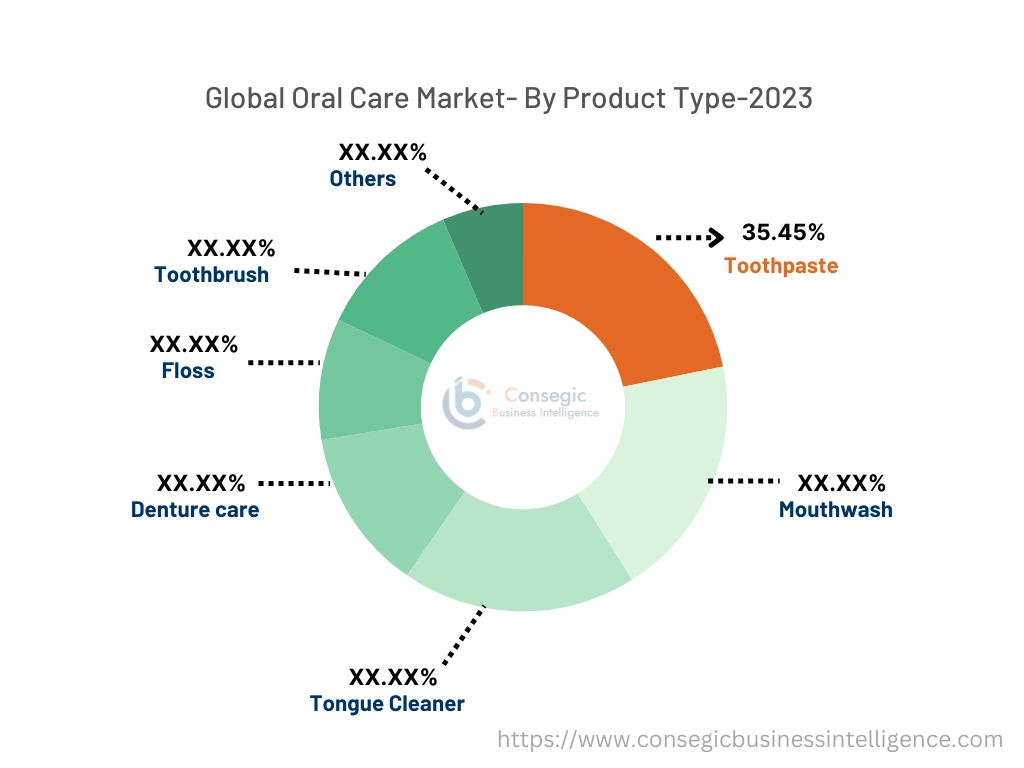
By Age Group:
Based on age group, the market is categorized into kids, adults, and geriatric.
Trends in the Age Group:
- Trends for products with bright colors, fun characters, and appealing flavors are popular to encourage regular brushing.
- Products designed to address specific oral health concerns of the elderly, such as dry mouth, gum disease, and tooth loss, are growing in popularity.
The adult segment accounted for the largest oral care market share in 2023.
- Oral care products play a vital role in maintaining optimal oral health for adults.
- Toothpaste helps strengthen tooth enamel and prevent cavities.
- Toothbrushes, ideally soft-bristled, effectively remove plaque and food particles from teeth and gums.
- Dental floss or interdental brushes clean between teeth, reaching areas toothbrushes cannot.
- Mouthwashes provide additional protection against bacteria and freshen breathing.
- For individuals with specific oral health concerns, specialized products like sensitivity toothpaste, whitening toothpaste, or gum care mouthwash can be beneficial.
- By incorporating these products into a consistent oral health care routine, adults maintain healthy teeth and gums, preventing gum disease, thus driving the segment expansion.
The kids segment is expected to grow at the fastest CAGR over the forecast period.
- Oral care for kids is essential for developing healthy habits and preventing future dental problems.
- Key oral health care products for kids include toothbrushes designed for small mouths and gentle bristles.
- Toothpaste specifically formulated for children often contains lower levels of fluoride and pleasant flavors to encourage regular brushing.
- Fluoride-free toothpastes are suitable for infants and toddlers to minimize the risk of accidental ingestion.
- Mouthwashes are introduced to older children to provide additional protection against bacteria.
- By incorporating these products into a daily routine and visiting the dentist regularly, parents help their children develop a lifelong commitment to good oral health.
- Additionally, manufacturers are introducing novel oral healthcare products such as toothpaste for kids that are available in appealing flavors.
- For instance, in 2024, Oral BioTech introduced CariFree Naturals Kids Toothpaste a gentle, fluoride-free toothpaste formulated with 40% xylitol and organic berry flavors. It is designed to clean even the smallest teeth without harsh chemicals or artificial ingredients.
- Thus, the use of oral health care products for kids is influencing the oral care market trends in the coming years.
By Distribution Channel:
Based on the distribution channel, the market is categorized into online and offline.
Trends in the Distribution Channel:
- E-commerce platforms utilize AI and machine learning to provide tailored product recommendations based on individual needs and preferences.
- Retailers are focusing on creating immersive in-store experiences, such as interactive displays, product demonstrations, and personalized consultations.
The offline segment accounted for the largest market share in the year 2023.
The offline segment is further categorized into hypermarkets/supermarkets, pharmacies, and others.
- The offline distribution channel remains a crucial platform for oral care products, reaching a wide range of consumers.
- Traditional retail outlets like supermarkets, grocery stores, and pharmacies are the primary distribution channels.
- These stores offer a variety of brands and product options, catering to diverse consumer needs.
- Additionally, independent pharmacy stores and convenience stores play a significant role, especially in local markets.
- To enhance visibility and sales, manufacturers often collaborate with distributors to ensure efficient product placement on store shelves.
- For instance, Salt Oral Care, a premium oral health care brand, has introduced a strategic partnership with the World Trade Center, Pune, to introduce its retail development across high-end channels including supermarkets and hypermarkets. This collaboration aims to elevate the brand's market presence and provide wider accessibility to consumers.
- Thus, the distribution of oral health care products through various offline channels is driving the oral care market demand.
The online segment is expected to grow at the fastest CAGR over the forecast period.
- Online channels have enhanced the distribution of oral care products, offering unprecedented convenience and accessibility.
- E-commerce platforms have become major marketplaces for oral healthcare products. These platforms provide a vast range of options, from basic toothbrushes and toothpaste to specialized products like electric toothbrushes, mouthwashes, and dental floss.
- Consumers are able to easily compare prices, read reviews, and make informed purchasing decisions from the comfort of their homes.
- Moreover, online retailers often offer exclusive deals, discounts, and subscription services, further enticing customers.
- The efficient integration of online channels has influenced consumers to conveniently purchase care products, driving the oral care market expansion.
Regional Analysis:
The regional segment includes North America, Europe, Asia Pacific, the Middle East and Africa, and Latin America.
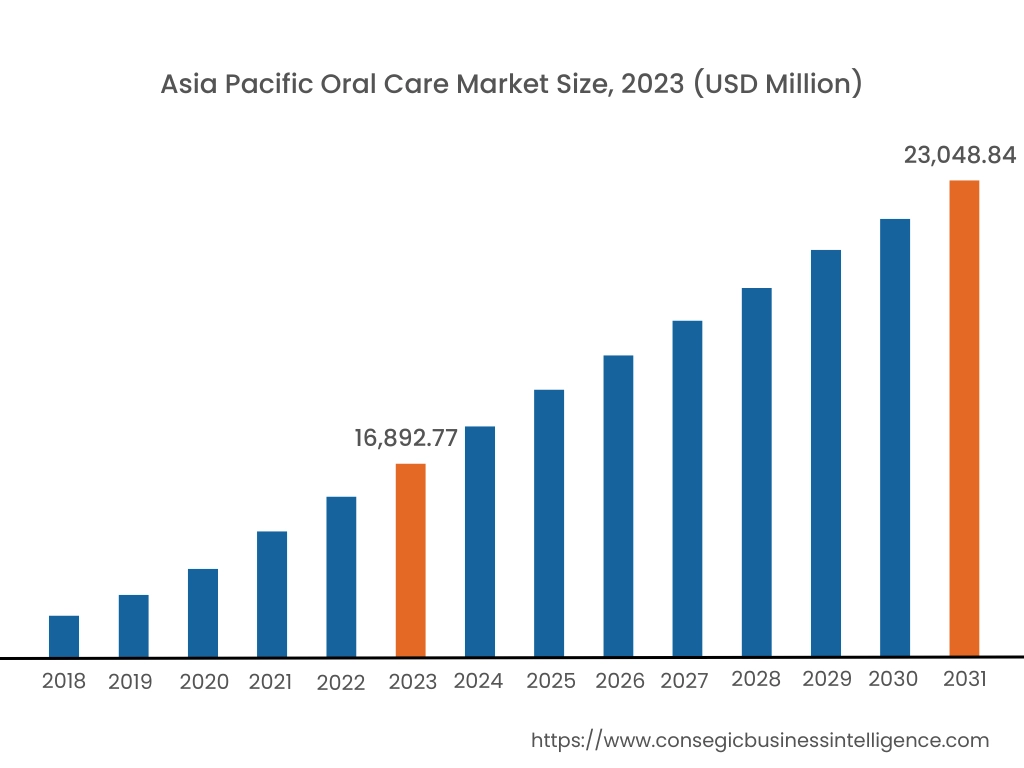
In 2023, Asia Pacific accounted for the highest market share at 34.40% and was valued at USD 16,892.77 Million and is expected to reach USD 23,048.84 Million in 2031. In Asia Pacific, China accounted for the highest market share of 23.10% during the base year of 2023. The regional growth is driven by factors like increasing disposable incomes, growing awareness of oral health, and urbanization. The market is dominated by countries like China and India, where an expanding middle class is fueling demand for premium products. Key product segments include toothpaste, toothbrushes, mouthwash, and dental floss, among others. Major players in the region are investing in research and development to introduce innovative products catering to specific regional needs. Additionally, the rise of e-commerce has opened up new distribution channels, making oral healthcare products more accessible to consumers across the region. As per the analysis, various manufacturers are partnering with dental colleges to educate students on dental health.
- For instance, in 2024, Sensodyne, a well-known brand for sensitive teeth, took a significant step to promote oral health awareness in India. In collaboration with 136 dental colleges across the country, the brand is organizing educational sessions as part of its BeSensitiveToOralHealth campaign.
Thus, the rise in the consumption of oral health care products in Asia Pacific is influencing the oral care market trends in the region.
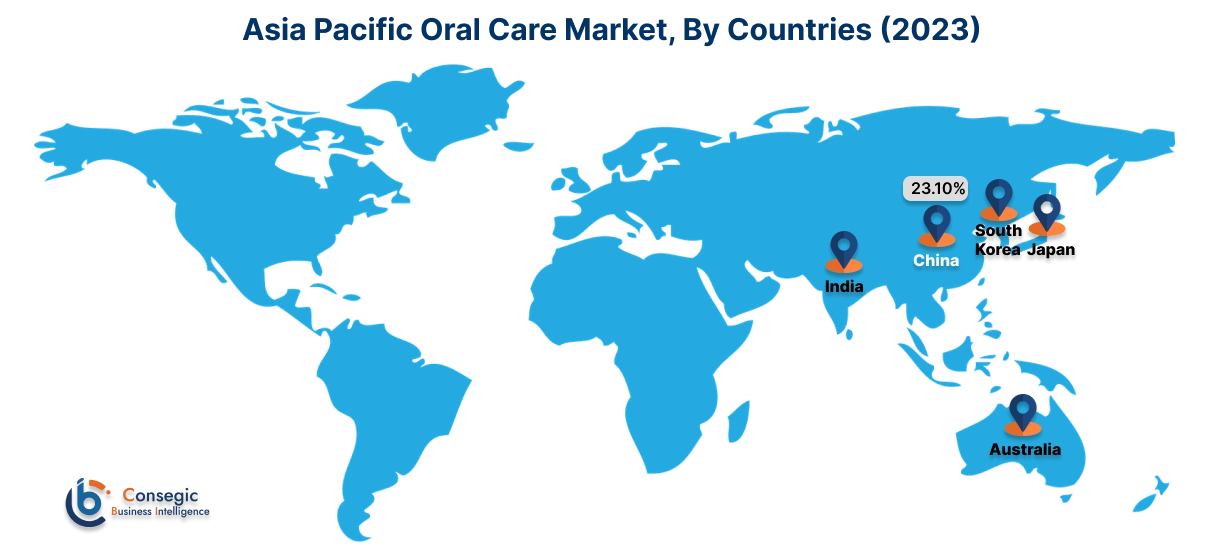
The North American market for oral health care is experiencing the fastest growth with a CAGR of 4.6% over the forecast period. North America is a major market for oral care products, with a strong emphasis on preventive dental care. Consumers in the region are increasingly aware of the link between oral health and overall well-being, leading to high demand for a variety of products, including toothpaste, toothbrushes, mouthwashes, dental floss, and teeth whitening products among others. Regular dental check-ups are widely practiced, and dental insurance often covers a significant portion of the cost. Additionally, there's a growing interest in specialty oral health care products like sensitive toothpaste, whitening strips, and electric toothbrushes. Moreover, as per the analysis, advanced dental technologies and smart oral health care devices cater to the needs of aging populations, thus driving the oral care market demand in the coming years.
Europe boasts a mature oral healthcare market with a strong focus on preventive dental care. Consumers in Europe are increasingly aware of the link between oral health and overall well-being, leading to high requirements for a variety of oral health care products, including toothpaste, toothbrushes, mouthwashes, dental floss, and teeth whitening products among others. Regular dental check-ups are widely practiced, and while dental coverage varies across countries, there's a growing emphasis on preventive care. Additionally, European consumers are open to trying innovative oral healthcare products, such as electric toothbrushes with advanced features and natural or organic formulations. Based on the oral care market analysis, the aforementioned factors are driving the market trends in the Europe region.
The Middle East and Africa present a diverse landscape for oral care, with varying levels of access and awareness. Toothpaste and toothbrushes remain the most fundamental oral health care tools, widely used across all socioeconomic groups. However, the landscape of oral health care is evolving, particularly among the middle and upper classes. These segments are increasingly adopting advanced oral health care products like electric toothbrushes and mouthwashes. Electric toothbrushes, with their timed brushing cycles and enhanced cleaning action, offer a more effective and convenient way to maintain oral hygiene. Based on the oral care market analysis, as the middle class expands, and healthcare infrastructure improves, the demand for oral healthcare products and services is expected to grow in the Middle East and Africa.
Latin America presents an active market for oral care products, with significant growth potential. While traditional oral health care practices, such as brushing teeth with natural products, persist in certain regions, the adoption of modern oral health care products is increasing. Toothpaste and toothbrushes remain the most commonly used products, but there's a growing requirement for specialized products like whitening toothpaste, sensitivity relief toothpaste, and mouthwash. Urban populations, particularly in Brazil, Mexico, and Argentina, are driving the demand for advanced oral health care products, including electric toothbrushes and dental floss. Thus, as the region continues to develop, the oral healthcare care market is expected to expand, driven by increasing awareness of oral health and rising disposable incomes.
Top Key Players & Market Share Insights:
The oral care market is highly competitive with major players providing products to the national and international markets. Key players are adopting several strategies in research and development (R&D) and product innovation to hold a strong position in the global oral care market. Key players in the oral care industry include-
- Colgate-Palmolive Company (United States)
- Procter & Gamble. (United States)
- Haleon Group of companies (United Kingdom)
- Kingfisher (United Kingdom)
- HEBEI FENGHE BIOTECHNOLOGY INC., LTD (China)
- Koninklijke Philips N.V. (Netherlands)
- Unilever (United Kingdom)
- Amway (United States)
- Dabur (India)
- ASPIRE ORALCARE P. LTD (India)
Recent Industry Developments :
Partnership:
- In 2024, ARM & HAMMER partnered with TheraBreath to develop a breath freshener toothpaste that provides healthier teeth and gums.
- In 2022, Colgate-Palmolive India, a leading oral care company, and Apollo Dental Clinics, a prominent chain of dental clinics, have collaborated to raise awareness about gum health. This partnership aims to educate the public about the importance of gum care and encourage regular dental check-ups.
Product Launches:
- In December 2024, Sensodyne introduced alcohol-free mouthwash for sensitive teeth. Sensodyne Complete protection+ mouthwash is formulated to complement daily brushing, offering additional protection for oral health.
- In December 2023, Amway India introduced a new addition to its oral care portfolio, the Glister Multi-Action Toothpaste. This innovative toothpaste is designed to provide comprehensive oral care, combining multiple benefits in a single product. The new Glister Multi-Action Toothpaste offers a unique blend of ingredients to effectively address various oral health concerns, such as tooth decay, plaque buildup, and mouth odor.
Oral Care Market Report Insights :
| Report Attributes | Report Details |
| Study Timeline | 2018-2031 |
| Market Size in 2031 | USD 426.62 Billion |
| CAGR (2024-2031) | 7.5% |
| By Product Type |
|
| By Age Group |
|
| By Distribution Channel |
|
| By Region |
|
| Key Players |
|
| North America | U.S. Canada Mexico |
| Europe | U.K. Germany France Spain Italy Russia Benelux Rest of Europe |
| APAC | China South Korea Japan India Australia ASEAN Rest of Asia-Pacific |
| Middle East and Africa | GCC Turkey South Africa Rest of MEA |
| LATAM | Brazil Argentina Chile Rest of LATAM |
| Report Coverage |
|
Key Questions Answered in the Report
How big is the Oral Care market? +
In 2023, the Oral Care market is USD 49,106.88 Million.
Which is the fastest-growing region in the Oral Care market? +
North America is the fastest-growing region in the Oral Care market.
What specific segmentation details are covered in the Oral Care Market? +
Product Type, Age Group, and Distribution Channel segmentation details are covered in the Oral Care market.
Who are the major players in the Oral Care market? +
Colgate-Palmolive Company (United States), Procter & Gamble. (United States), Koninklijke Philips N.V. (Netherlands), Unilever (United Kingdom), Amway (United States), Dabur (India), ASPIRE ORALCARE P. LTD (India), Haleon group of companies (United Kingdom), Kingfisher (United Kingdom), HEBEI FENGHE BIOTECHNOLOGY INC.,LTD (China).
